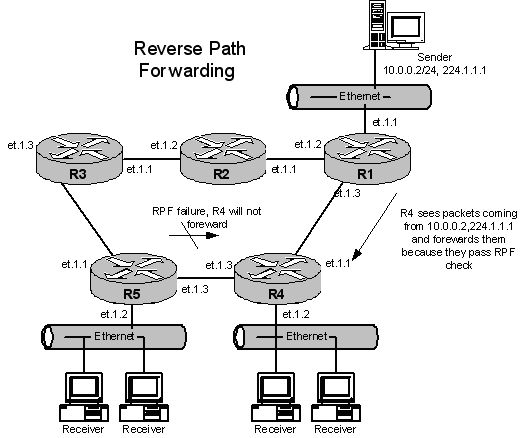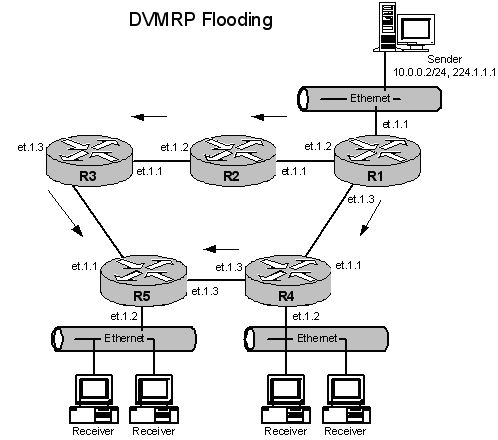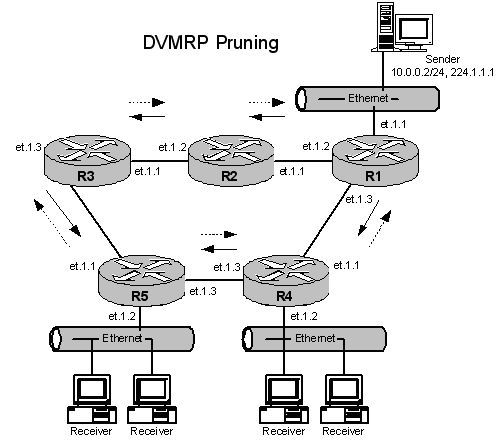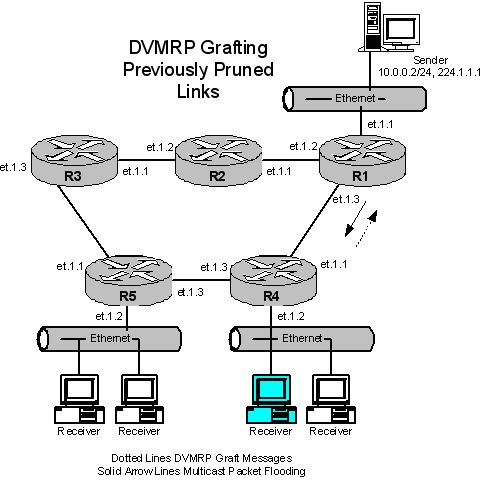
DVMRP PROCESS |
DVMRP USES MULTICAST FORWARDING...
DVMRP uses Reverse Path Forwarding (RPF) to determine the best (shortest) path back to the source. The router examines all the packets received as input to make sure that both source address and interface are in the routing table. It looks up the source address in the forwarding table and compares that entry with the receivng entry (RFP check). If the interface and entry do not match or are not in the table, then the packets are discarded. If there is a match, then the router forwards the packets.

DVMRP CONSEQUENTLY HAS A MAINTANENCE ALGORITHM...
Periodically, the source performs what is known as flooding in order to push datagrams downstream. Initially, DVMRP routers assume that every node on the connected subnets wants to receive data. Along with the datagrams, a packet called the ROUTE REPORT is transmitted (across a time interval). All the routes known by a given router is sent to all adjacent routers. By using IGMP, the routers are aware of which hosts are connected to the subnets. On receiving the ROUTE REPORTS, a router selects the best adjacent router through which it can reach the given source network.

After registering that router as the UPSTREAM NEIGHBOR, a DEPENDENCY is expressed to the router for receiving packets. Upon receiving this DEPENDENCY, the receiving router registers the expressed DEPENDENCY as its DEPENDENT DOWNSTREAM NEIGHBOR.
Hence, an optimal multicast spanning tree is constructed. On receiving a multicast packet, a router accepts that packet for forwarding if and only if the packet is received from the UPSTREAM NEIGHBOR. Otherwise, it will be dropped.
Then, the list of the DEPENDENT DOWNSTREAM NEIGHBOR is verified and the Lower Layer protocols forwards the packets to the specific neighbors. If there are no DEPENDENT DOWNSTREAM NEIGHBORS, PRUNE MESSAGES are sent to the UPSTREAM NEIGHBOR, requesting that the router should stop sending packets from the specified source network for a specified amount of time.

Thus, datagrams will no longer be transmitted along that path (cutting down on the bandwidth being used). After a prune interval, packets will be flooded downstream again, along the shortest path trees.
If any other routers expresses some dependencies, GRAFT MESSAGES are sent to that UPSTREAM NEIGHBOR. Upon receiving an acknowledgement, GRAFTACK MESSAGES are expected back. On receiving a GRAFT MESSAGE from a DOWNSTREAM NEIGHBOR, multicast packets will be sent on that interface.

The above procedures of Pruning and Grafting could initiate a similar action in the receiving routers. This means that unnecesary data traffic will be reduced in the network, which is the advantage of DVMRP.